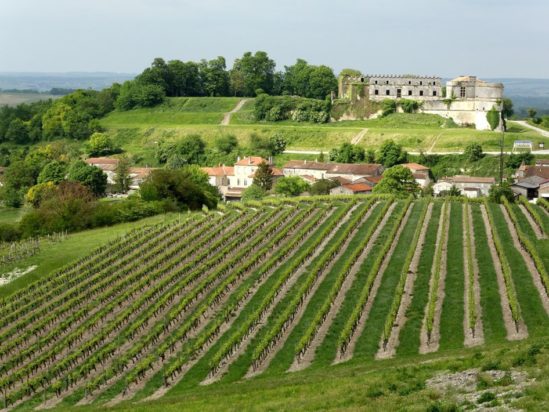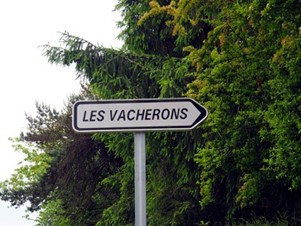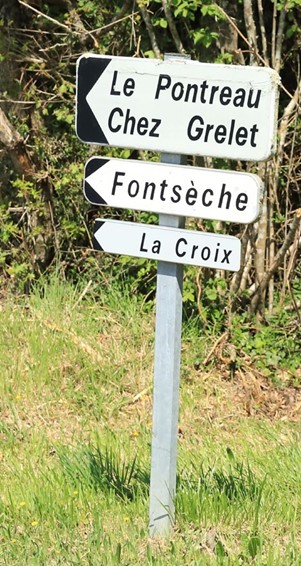From towns to places, landscapes marked by settlements and human activities part 1
The toponyms, or place names, are one of the revelations of the history of the Cognac appellation since Gallo-Roman times. They give an account of the humanization of the environment and its consequences on the landscape.

© Michel Guillard
The terroirs of Cognac, which cover more than 80,000 hectares and extend over four departments (Charente-Maritime for the most part, Charente for a large part and a few communes in the Deux-Sèvres and Dordogne), are striking for their variety. Although the vineyards are predominant, especially in the east, the woods, the meadows, the cereal crops and the maritime vegetation all contribute to their diversity. The toponymy, which was established long before the advent of Cognac, takes this into account. It also reveals the particular humanization of the area. We can decipher in the toponymy a history of settlements, discover the characteristics of the habitat of men, their activities, their ways of life. Landscapes have gone from being natural to being cultural over the course of history, and toponymy is one of the indicators of this.
When the linguist considers the names of the communes and localities of the region, without claiming to be exhaustive, he is struck by the distant echoes of the original languages of the first inhabitants, from pre-Celtic, Gallic, Latin and Frankish words to the names of ancient French, from medieval French to the langue d’oc, or to the names of modern French. It is the whole history, from the Santons to the Charentais, which is written in the places and sculpts the landscapes by making appear, according to the times, the dominant ones of the environment.
If toponyms of pre-Celtic origin are rare in our region as everywhere in France, we can note however the places named La Groie and La Grouasse (with pejorative suffix) (Cherves- Richemont), La Groie, Grave (Meursac), Graves (Petite Champagne), Cravans (with muted initial), rather widespread forms which would come, like the French grève or the Bordeaux graves (“wine of the gravels”), from a prelatin *grava, “sand, gravel”, to indicate the nature of the soil, favourable to the viticulture. The name Les Mathes (or Les Mattes until the 19th century) would come from a prelatin root *mutt(a) which gave the Saintongeais motte, “marshy land”, probably justified by the fact that the medieval village of this commune was built on an island in the middle of the vast pond of Barbareu, dried up since.
This rarity, which is not original if one refers to all the French place-names, is compensated by a greater number of Gallic or Gallo-Roman toponyms. Thus, the name of Cozes would be derived from the Gallo-Roman anthroponym Cottius, from the Gallic cottos, “old”, Le Chay, from the Gallic caio, which gave, in Poitou and Saintonge, the word chai (and in French the word quai) and Chaillevette, from chail, which designates a stone and, by extension, a very calcareous earth, modified in French by the well-known diminutive -ette. Place names also go back to the Gallic period by their suffix -euil (Gaul. iolos “clearing”, found in Welsh). The determinate is either a personal name or a geographical element which is thus anteposed according to Celtic syntax. We can think that Criteuil (Christolio, 1083-1098) means the clearing of Christos. The second element was then emptied of its meaning and the compound became a derivative whose final was transformed into -oialos with an accent on the o, which explains the subsequent phonetic evolution into -euil. The same process accounts for Bonneuil (Bonolio in 1098-1109) which would be the field or clearing of Bonos.
The Romanization that the Gauls underwent was so profound that their dialects almost completely disappeared except in agricultural vocabulary or in morphological forms and syntactic orders. The toponyms took on new names due to the clearing of land and the expansion of trade or construction. A city like Saintes was called by the Latin name of Mediolanum Santonum which evokes the central position of the agglomeration within the territory occupied by the Santons. The term Mediolanum, found in the names of several ancient cities, eventually disappeared gradually, the city being referred to as Santonica Urbs or Urbs Santonorum from the 4th century, i.e. the city of Santons. In the 8th century, the charters indicate a Sanctonas which becomes Sanctone in the 10th century and Xainctes (sometimes spelled Xaintes) at the end of the Middle Ages. An infinite number of words of Latin origin designating characteristic places were used, such as côteau, font, mont, combe, pallue…, and replaced the Gallic roots
But it is undeniably a small Gallic suffix, -acos, latinized into -acum (“at”), which had the most brilliant career in Roman times. It mostly follows a personal name, most often Roman in -us. It thus indicates, through the name of the owner, the name of the domain. This formation continued until the Frankish period, since we find this suffix after Germanic names. Its development is linked to the expansion of agriculture in Roman Gaul. It evolved into -ay, -é, -ié, ieu(x) or -y in the Oïl language (e.g. Vitray, Vitry) and into -ac in the Oc language (e.g. Vitrac).
The Saintonge, like the rest of the Charentes, belonged to the Oc language until the 12th-13th centuries, and many place names have kept the -ac form, such as Chérac, Cognac, Javrezac, Louzac, for the names of the Borderies municipalities. Chérac would be the domain of a certain Carrius, Cognac that of Connius, a Latin family name derived from the Gallic Connus, Javrezac, the property of a Gallo-Roman Gabritus, a variant of Gabritius, and Louzac that of a Gallo-Roman Laudius or of a Gallic Lüteus. It is the same for Segonzac (Secundiacum in 1097) which would be the domain of Secundius, for Touzac (Talziaco, Tauzac in 991-1018) that of Tautius, for Angeac-Champagne (Andiacum before the 8th century; the term Champagne was added to the name of the commune in 1801 to distinguish it from its homonym Angeac-Charente), the property of a rich Gallo-Roman named Andius, of Julliac-le-Coq (Julliaco in 1095), domain of Julius, the name of an owner Lecoq having been added to distinguish it from Petit Juillac (commune of Saint-Martial-sur-Né).
But Genté (Agento in 1110), the domain of a Gaul named Agen, is one of the rare toponyms to have undergone an evolution proper to the Oïl domain (like Vitray). The fact is found elsewhere (Aulnay), which attests but rarely the mixed character of the Oc and Oïl languages before the XIVth century, because it is indeed the multiplicity of the toponyms in -ac which registers the Charentais soils in the Oc movement. We can still point out, and the list would be long, Gémozac (villa Gemutii), vast Gallo-Roman domain of the Germanic Germodus, Meursac (Murciacum), possession of the Latin Murcius, Mornac-sur-Seudre, domain of Morinus, Plassac (or Blacciacum), property of Blacius, whose Gallo-Roman settlement is attested by the discovery of the remains of three Gallo-Roman villas, dating from the 1st to the 2nd century A.D., Grézac (or Gratiacum), domain of Gratius, Saint Ciers-du-Conac or Saint-Cyr-de-Taillac (other appellations of Saint-Ciers-du-Taillon) belonging, in the 18th century, to the county of Cosnac (property of Cosnus). In Saint- Just-Luzac, Luzac indicates the possession of Lucius and probably designates a Gallo-Roman villa established at this place).
Next to this very productive suffix, a new suffix appears, with the same meaning, in the forms -anum or -onum which are only used in certain southern regions. Curiously, it is found in competition with -acum in Saint-Cyr-du-Taillac and Saint-Ciers-du-Taillon, the same toponyms which both indicate the property of a certain Tallus. It is found in Saujon (Salvianonem or villa Salvii), possession of the Gallo-Roman Salvio and which later passed through the normally expected forms Savion, Saujean, Royan, a toponym which also appears in other southern regions. Its Latinized forms are Roiannum or Roianum in the 11th century. It would be a Roman villa belonging to a certain Roius. In Montpellier-de-Médillan, the last word also indicates the domain owned by a Gallo-Roman named Metelius or Medillus.
The cultivation of the land under the Roman Empire continued during the Frankish period and the new domains bore the name of their owner followed by a word designating the rural property: town (lat. villa, which already had this meaning in the Roman world), court (lat. cohors “farmyard”) and some rarer words with a locative meaning (mount, valley, bridge). In the South-West and in Grande Champagne, in relation to the Frankish settlements of Aquitaine after the 6th century, it is the first one that was used: Éraville (Ayrasvilla in 1291) would be the domain of Airard, Viville (Vievilla, Vieyvilla around 1300), preceded by the adjective vi (lat. vetus “old”), would designate an ancient rural domain, Malaville (Malavilla in 1075), the domain of Mala, Bouteville (Botavilla in 1097) that of Boto, Ambleville (Amblavilla in 1121) that of Amblinus or Amelinu. The syntax which antecedes the possessor before the possessed element is in conformity with that of the period concerned. Nieulle-sur-Seudre which represents the oldest Neuville, meaning new town, nevertheless testifies to this.

© F. Argod-Dutard
At the end of the 10th century, after the Great Invasions, a period of stabilization in the feudal organization began in France. The toponymy will complete its main lines; from the 13th century onwards, innovations will be limited to the localities. Rural life was concentrated around defensive places: Château-Bernard (Castro Bernadi) would go back to the Latin castellum (“castle”), diminutive of castrum (“stronghold”), and to a personal name of Germanic origin Bernard, probably the lord. Salles-d’Angles (Salis in Campania before the 15th century; created in 1793, this commune absorbed that of Angles) would derive from the Germanic seli, in German saal, designating “the room, the castle”, just like Salles-de-Barbezieux.
With the creation of new towns, new words appeared in the designation of places, such as bourg, which can be found in Bourg-sur-Charente (Burgo Canrantonio) or Taillebourg, both formed from the Low Latin burgus, “fortified place”, borrowed from the Germanic burgs in the 5th century. Towards the 12th-13th centuries, new formations were born, by derivation of domain names. The most used suffix is -ier, often feminine and preceded by the article. In Grande Champagne, Lignières (Lineriis in the 13th century; Lignières absorbed Sonneville in 1845) is a good example. This term comes from the Gallo-Roman linariu, linarias: “land where flax is grown” (the modern spelling has been influenced by “line”). Les Tribaudières also attests to this formation. Tripault refers to a person of French origin and the suffix -ieres in the feminine plural indicates his possessions in the commune of Cherves-Richemont. The same toponym is also found elsewhere in France, notably in the commune of Thénioux (Cher).
The names of new rural domains can still be formed with the suffix -erie or -ie, which indicates a whole, a place according to the name of the owner, a speciality or a particularity. Among the numerous toponyms formed in this way (La Rauderie, La Tacharderie, La Gandourie, La Garnerie…), let us note La Richonnerie (Chérac) or La Rochonnerie (Cherves-Richemont), which became personal names in the 14th century, indicating the possession of a certain Richon (rich with a suffix -on, augmentative or diminutive according to the occurrences), and La Rauderie, a place of pleasure, unless it was the domain of a certain Arraut. As for the word Borderies, it is a less clear occurrence. In principle, the word is formed from the suffix – erie or – ie and the radical borde which has its origin in the Occitan borda “farm, small holding” but also “agricultural surface that could be ploughed in the year by a pair of oxen, depending on the region”.
The Borderies are thus a group of small farms. But we can also think that it is an older formation, notably an adaptation of medieval Latin bordaria (from Frankish *borda “hut of boards”, a neuter plural of collective meaning that became feminine), attested in 1031 and present in Provençal in 1120. Whether it was a French suffix or an earlier borrowing, the meaning is the same and one can imagine that a cross between the meaning of borde and that of the verb border, originally present in Germanic and English, may have occurred in the particular context of the region where vines rub shoulders with the woods. This word is thus an example of the crossing at an early date between Oc and Oïl formations in Saintonge.

© Michel Guillard




